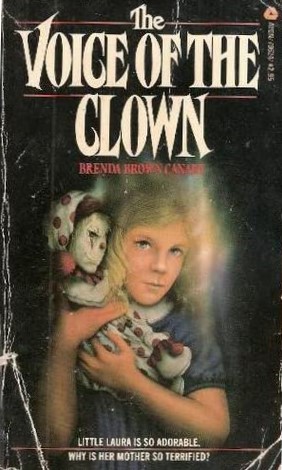 By BRENDA BROWN CANARY (Avon; 1982)
By BRENDA BROWN CANARY (Avon; 1982)
For much of its existence this long out-of-print novel was just another of the countless undistinguished horror paperbacks that cluttered the 1980s fiction market. It took until 2017, with the release of PAPERBACKS FROM HELL by Grady Hendrix, for THE VOICE OF THE CLOWN to achieve its current ranking as the internet’s most widely sought-after (after BIG GURL) horror novel.
Hendrix has proclaimed it “thrilling and awesome and grotesque in all the best ways,” and “the only book to make my jaw drop on more than one occasion.” Hence the online stampede of interested readers (and my biggest overall complaint about PAPERBACKS FROM HELL: it’s turned what were formerly considered disposable commodities into expensive collectors’ items, meaning the days when it was possible to obtain a vintage horror paperback for under $5.00 are long gone). Repeated attempts have been made to bring it back into print by Valancourt Books, but they’ve come to nothing due to the fact that author Brenda Brown Canary hasn’t responded to their overtures.
As one of the lucky few who grabbed a copy of THE VOICE OF THE CLOWN before it became prohibitively expensive (no joke: the cheapest copy on Amazon.com is currently $505.99), I can report that, frankly, it’s not the book Mr. Hendrix thinks it is. Yet his claims about it aren’t entirely off the mark, as it is indeed a jaw-dropper.
It’s the story of Laura, a six year old girl with a possessed clown doll. The supernatural business, the result of Native American sorcery emanating from a mountain near Laura’s parents’ house, is easily the weakest portion of the book, which is at its best in its depiction of the familial havoc wreaked by Laura’s jealousy and upset, directed at her stepmother and the latter’s newly birthed infant. Under the dictates of the clown Laura pretends to be mute, speaking only to her mother, and only in private. This makes everyone else think the poor woman is insane, and leads to passages of jump-out-of-your-seat depravity, the most potent of which occurs around two-thirds of the way in.
To get to the point, unfortunately, one has to wade through prose that’s quite lugubrious. It’s bunched into extremely lengthy paragraphs, and laced with intricate descriptions that requite close attention on the part of the reader. A much greater problem is that the aforementioned shocking passage is so impacting it all-but obliterates everything that comes after. The author makes a valiant attempt at closing things out with a bang, throwing in telekinesis, reincarnation, a Native American medicine man and much assorted mayhem, but it’s all for naught, as the book effectively peaks on page 203.
